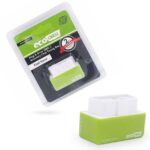Ensuring your 8th generation Honda Civic passes its emissions test is crucial, and understanding OBD2 readiness codes is a key part of this process. These codes are a series of system checks your car performs to verify its emissions control systems are functioning correctly. If these codes aren’t set properly, your Civic might fail its emissions test, even if there isn’t a major problem. This guide will explain what OBD2 readiness codes are, how to check them on your 8th gen Civic, and the procedures to set them so you can confidently pass your DEQ (Department of Environmental Quality) or similar emissions testing.
Understanding OBD2 Readiness Codes in Your 8th Gen Civic
OBD2 (On-Board Diagnostics II) systems monitor various components of your vehicle, especially those related to emissions. Readiness codes, also known as readiness monitors, are indicators that show whether these monitors have completed their diagnostic cycles. When your Civic’s battery is disconnected, Diagnostic Trouble Codes (DTCs) are cleared, or the Engine Control Module/Powertrain Control Module (ECM/PCM) is reset, these readiness codes also reset to an “incomplete” state.
For emissions testing, many regions require these readiness codes to be in a “complete” or “ready” state. If they are not, the test may be inconclusive or result in a failure. This is where understanding how to manage these codes for your 8th gen Civic becomes essential, particularly when preparing for a DEQ inspection.
Checking 8th Gen Civic OBD2 Readiness Status
You can easily check the status of your 8th gen Civic’s readiness codes without specialized tools, simply by observing the Malfunction Indicator Lamp (MIL), also known as the check engine light, when you first turn the ignition on.
Here’s how:
- Turn the ignition switch to the “ON” position (II), but do not start the engine.
- Observe the MIL in your instrument cluster.
- Readiness Codes Complete: If the MIL illuminates for approximately 15-20 seconds and then turns off, it indicates that all readiness codes are set to “complete.”
- Readiness Codes Incomplete: If the MIL flashes five times after the initial illumination, it signals that one or more readiness codes are not yet set to “complete.”
Alt text: Honda Civic dashboard with the Malfunction Indicator Lamp (MIL) illuminated, indicating a potential engine issue or emissions system problem.
For more detailed information and to check the status of specific systems, you will need an OBD2 scan tool, ideally one that can access Honda-specific data. A tool like the Honda Diagnostic System (HDS) provides the most comprehensive view, but aftermarket OBD2 scanners can also offer valuable insights. These tools allow you to access the DTC MENU and check the OBD status screen, which displays codes, enable criteria, and readiness testing status for individual monitors.
Setting OBD2 Readiness Codes on Your 8th Gen Civic: Step-by-Step Procedures
If your 8th gen Civic’s readiness codes are incomplete, you’ll need to perform specific drive cycles to allow the vehicle’s self-diagnostic systems to run and complete their checks. Below are the procedures for some common monitors. Remember, do not turn the ignition switch off during these procedures unless explicitly instructed.
Important Notes for Setting Readiness Codes:
- Battery and ECM/PCM Reset: All readiness codes are cleared when the battery is disconnected or the ECM/PCM is reset using a scan tool.
- Temperature Considerations: Low ambient temperatures or heavy stop-and-go traffic can extend the time needed to set readiness codes.
- Enable Criteria: Readiness codes will only switch to “complete” once all specific “enable criteria” for each monitor are met.
- Pre-existing Faults: If a fault exists in an emissions system component, such as a faulty secondary HO2S sensor, the corresponding readiness code cannot be set to “complete” until the fault is corrected.
1. Catalytic Converter Monitor and Readiness Code
The catalytic converter monitor ensures your Civic’s catalytic converter is functioning efficiently to reduce emissions.
Enable Criteria:
- Engine Coolant Temperature (ECT) at 158 ºF (70 ºC) or more.
- Intake Air Temperature (IAT) at -13 ºF (-25 ºC) or more.
- Vehicle Speed Sensor (VSS) reading above 3 mph (5 km/h).
Procedure:
- Connect an HDS or OBD2 scanner to your Civic’s Data Link Connector (DLC) and navigate to the READINESS CODEs screen for Catalyst in the DTCs MENU.
- Start the engine.
- Test-drive under stop-and-go conditions with short periods of steady cruising. Drive for approximately 5 miles (8 km).
- Recheck the Readiness Codes screen. The Catalyst monitor should now be “complete.”
- If still incomplete, check for Temporary DTCs with the scanner. If no DTCs are present, repeat the procedure, ensuring all enable criteria are met.
2. Evaporative Emission (EVAP) Control System Monitor and Readiness Code
The EVAP system monitor checks for leaks in your Civic’s evaporative emissions system, which prevents fuel vapors from escaping into the atmosphere.
Enable Criteria:
- Battery voltage above 10.5 V.
- Engine at idle.
- ECT sensor between 176 ºF (80 ºC) and 212 ºF (100 ºC).
- Manifold Absolute Pressure (MAP) sensor reading less than 46.6 kPa (14 in.Hg, 350 mmHg).
- Vehicle speed 0 mph (0 km/h).
- IAT sensor between 32 ºF (0 ºC) and 212 ºF (100 ºC).
Procedure:
- Connect an HDS or OBD2 scanner to the DLC.
- Start the engine.
- Using the HDS, select EVAP TEST in the INSPECTION MENU, then FUNCTION TEST in the EVAP TEST MENU.
- If the function test is normal, the EVAP readiness code should be complete.
- If still incomplete, check for temporary DTCs and repeat the procedure, ensuring all enable criteria are met.
3. Air Fuel Ratio (A/F) Sensor Monitor and Readiness Code
This monitor checks the functionality of your 8th gen Civic’s Air Fuel Ratio sensor, crucial for maintaining optimal fuel efficiency and emissions.
Enable Criteria:
- ECT at 158 ºF (70 ºC) or more.
Procedure:
- Start the engine.
- Test-drive under stop-and-go conditions with short periods of steady cruise.
- During the drive, decelerate with the throttle fully closed for 5 seconds. Drive for about 3.5 miles (5.6 km).
- Check the readiness codes screen for the Air Fuel Ratio (A/F) Sensor in the DTCs MENU.
- If “complete,” readiness is set. If not, proceed to the next step.
- Check for Temporary DTCs. If none are found, check ECT in the DATA LIST menu. Ensure ECT is above 158 ºF (70 ºC); if not, run the engine until it reaches this temperature and repeat the procedure.
4. Air Fuel Ratio (A/F) Sensor Heater Monitor Readiness Code
This monitor specifically checks the heater circuit of the A/F sensor, ensuring it reaches operating temperature quickly for accurate readings.
Procedure:
- Start the engine and let it idle for 1 minute.
- Check the readiness codes screen. The A/F Sensor Heater monitor should switch to “complete.”
- If still incomplete, check for temporary DTCs. If none, repeat the procedure.
5. EGR Monitor and Readiness Code
The Exhaust Gas Recirculation (EGR) monitor verifies the EGR system’s operation, which reduces NOx emissions by recirculating exhaust gas back into the intake manifold.
Enable Criteria:
- ECT at 176 ºF (80 ºC) or more.
Procedure:
- Connect an HDS or OBD2 scanner to the DLC.
- Start the engine.
- Drive at a steady speed between 50-62 mph (80-100 km/h) in D (Automatic Transmission) or 4th gear (Manual Transmission) for more than 10 seconds.
- Decelerate from 62 mph (100 km/h) or above by fully releasing the throttle for at least 5 seconds in D or 4th gear. If the engine stops, return to step 2 and repeat.
- Check the OBD status screen for DTC P0401 in the DTC’s MENU with the HDS.
- If “passed,” EGR readiness is complete. If not, retest from step 3.
Alt text: A detailed view of an 8th generation Honda Civic engine bay, showcasing various components relevant to OBD2 monitoring and emissions control.
Continuously Monitored Systems:
Some readiness codes, like those for the Misfire Monitor, Fuel System Monitor, and Comprehensive Component Monitor, are continuously monitored whenever the engine is running and are typically always set to “available” or “complete.”
Passing Your DEQ Test with Confidence
By understanding and correctly setting the OBD2 readiness codes on your 8th gen Civic, you can significantly increase your chances of passing your DEQ or emissions test. Always address any underlying issues that prevent readiness codes from setting, as these often indicate real problems within your vehicle’s emissions control systems. Using these procedures will help ensure your Civic is not only running efficiently but also environmentally responsibly.

